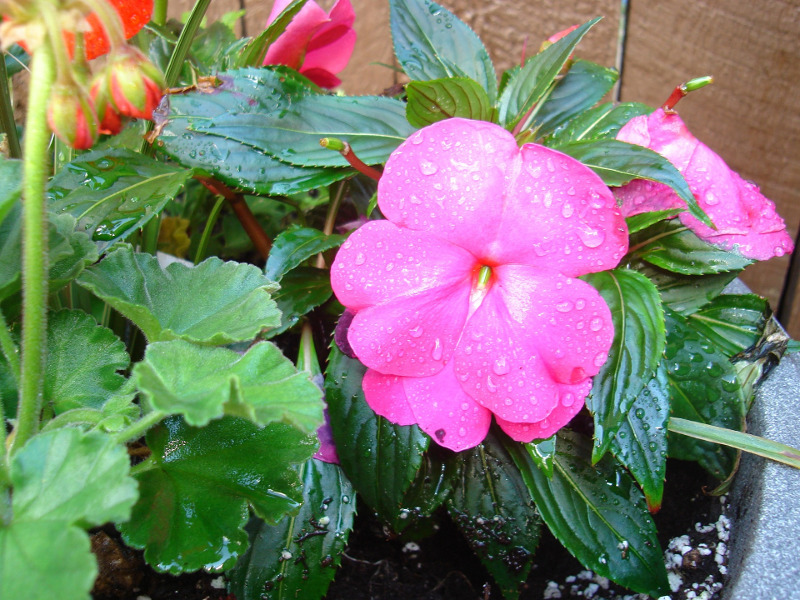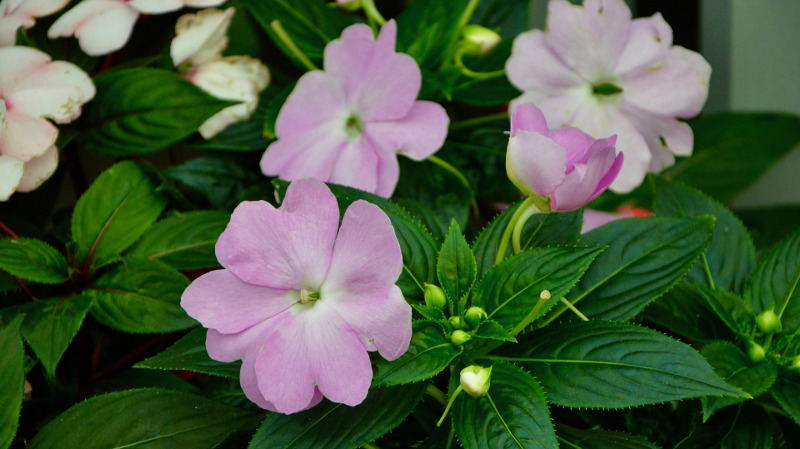Impatiens is a genus of more than 1,000 species of flowering plants, widely distributed throughout the Northern Hemisphere and the tropics. Together with the genus Hydrocera, Impatiens make up the family Balsaminaceae. Common names in North America include impatiens, jewelweed, touch-me-not, snapweed and patience.
Considered a herbaceous perennial in USDA zones 10-11, Impatiens are grown as an annual in most regions of the country. This shade loving plant grows 10-16 inches tall and 10-15 inches wide. Blooming in colors of white, red, pink, violet, coral, purple, and yellow, Impatiens are a favorite choice for adding color to the garden. Use as bedding plants, container fillers, hanging baskets, or groundcover.

Planting Impatiens
Impatiens are sensitive to cold temperatures. Do not plant until the threat of frost has passed. This plant likes rich, moist, well-drained soil. Space the plants closer together to encourage taller growth in containers.
Space plants out to spread if used for ground cover. Choose a shady area to plant Impatiens. Too much heat and sun will cause the plant to droop.
Watering Impatiens
Impatiens are not drought tolerant. Regular watering and consistently moist soil will prevent the plants from wilting. Adding a layer of mulch around the base of the plant will help to retain moisture. Impatiens planted in the ground will need at least 2 inches of water each week, 4 inches of water per week if over 80 degrees.
Container grown Impatiens will require daily watering when it is hot outside. Too dry of soil will result in a wilted plant. A good drink of water will make the plant bounce right back.

Fertilizing Impatiens
Impatiens will produce more flowers if fertilized regularly. At the time of planting, apply a slow-release granular fertilizer. Halfway through the summer, feed the plant again. Another option is to apply a water-soluble fertilizer every two weeks throughout the spring and summer. Consistent fertilizing throughout the growing season will give the plant energy for continued production of blooms. Careful not to over fertilize as this could cause a leggy plant with few blooms.
Pruning Impatiens
Although Impatiens are fairly low-maintenance, they can benefit from some pruning. There are times when this plant can become leggy, with more stems than blooms. Simply pinch back the plants to encourage bushier growth. After the flowers fade, pinch the top of that stem off to encourage new growth and blooms. This can be done regularly throughout the growing season.

Caring For Impatiens in Pots
Impatiens are not drought tolerant and will quickly wilt in dry conditions. When growing in containers, Impatiens will need well-draining potting soil. Choose a container that has drainage holes. Place the container in a shady location. It is best to water this plant when the top inch of soil feels dry to the touch. Give the plant a slow long drink of water each time.
Container plants should be fed every other week, using a general-purpose liquid fertilizer.
Winter Care for Impatiens
Container grown Impatiens can be brought indoors for the winter time. Make sure that the pot has drainage holes, as overwatering during the winter can be a problem. Remove any old blooms and dead leaves. Check the plant for any pests and remove them. Place the container in a sunny location, avoiding direct sunlight.
Avoid fertilizing, as you do not want the plant to necessarily bloom. Winter time is rest time for the plant. Resume fertilizing in the spring.
Common Impatiens Care Questions
What Is The Growth Rate Of Impatiens?
Impatiens are a slow grower, but can eventually get up between 6 and 30 inches, depending on what variety they are.
Do Impatiens Spread?
Impatiens do spread with an aggressive and unusual seeding habit. The seed pods have an increasing amount of pressure from the inside and can burst open at any time when touched or even a big gust of wind.
Do Impatiens Come Back Every Year?
Impatiens are a tender perennial, but in most areas are grown as an annual, but they can be self-seeding.
Do Impatiens Need Sun Or Shade?
Impatiens are shade-loving plants and do best with 2 to 4 hours of filtered or dappled sunlight in the mornings and shade during the hot afternoon hours.
Why Do Impatiens Leave Turning Yellow?
Yellowing leaves on impatiens can be indicative of a few things. Under- or over-watering (they prefer consistently moist, but never soggy, soil) an infestation of small, skinny little worms called nematodes in the soil damaging the roots, or fungal infection of downy mildew.
Have a question about Impatiens? Fill out the form below and we will try and get back to your question as soon as possible. We may even feature your question in this article to help other gardeners!
 |
Author Chris Link - Published 07-23-2021 |
